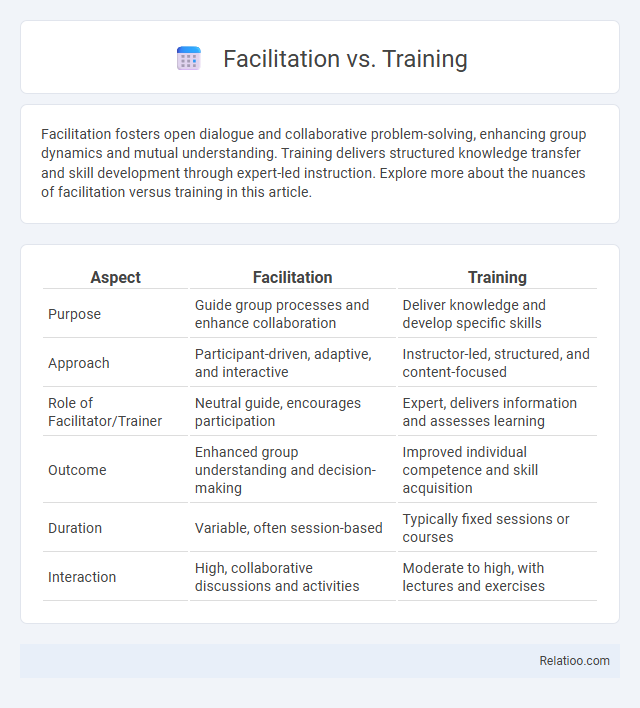Facilitation fosters open dialogue and collaborative problem-solving, enhancing group dynamics and mutual understanding. Training delivers structured knowledge transfer and skill development through expert-led instruction. Explore more about the nuances of facilitation versus training in this article.
Table of Comparison
| Aspect | Facilitation | Training |
|---|---|---|
| Purpose | Guide group processes and enhance collaboration | Deliver knowledge and develop specific skills |
| Approach | Participant-driven, adaptive, and interactive | Instructor-led, structured, and content-focused |
| Role of Facilitator/Trainer | Neutral guide, encourages participation | Expert, delivers information and assesses learning |
| Outcome | Enhanced group understanding and decision-making | Improved individual competence and skill acquisition |
| Duration | Variable, often session-based | Typically fixed sessions or courses |
| Interaction | High, collaborative discussions and activities | Moderate to high, with lectures and exercises |
Understanding Facilitation: A Clear Definition
Understanding facilitation involves guiding group processes to promote collaboration and effective communication without dictating outcomes. Unlike traditional training, which focuses on knowledge transfer and skill development, facilitation emphasizes creating an environment where participants actively contribute and co-create solutions. Effective facilitation requires skills in managing group dynamics, encouraging participation, and fostering mutual understanding to achieve collective goals.
What is Training? Key Concepts Explained
Training is a structured process designed to develop specific skills, knowledge, and competencies in individuals or groups through systematic instruction and practice. It focuses on equipping Your team with measurable abilities aligned with organizational goals, often using predefined curricula and performance assessments. Unlike facilitation, which guides group interaction and problem-solving, training delivers targeted content to enhance expertise and productivity.
Core Differences Between Facilitation and Training
Facilitation centers on guiding group discussions and decision-making processes to achieve collaborative outcomes, while training focuses on delivering structured knowledge and skills to learners. Facilitation empowers Your team to engage actively and share insights, fostering collective problem-solving rather than just absorbing information. Core differences lie in facilitation's emphasis on process and group dynamics versus training's goal of skill acquisition and content mastery.
Goals and Objectives: Facilitation vs Training
Facilitation centers on guiding group discussions and decision-making processes to achieve collaborative goals, while training focuses on imparting specific skills and knowledge to enhance individual performance. Your objectives in facilitation emphasize creating a supportive environment for shared understanding, whereas training goals prioritize measurable learning outcomes and competence development. Understanding the distinction helps tailor your approach to either fostering engagement or delivering targeted instruction effectively.
Roles and Responsibilities of Facilitators and Trainers
Facilitators guide group discussions and processes to foster collaboration and ensure all voices are heard, focusing on managing dynamics rather than delivering content. Trainers, on the other hand, are responsible for imparting knowledge, skills, and specific competencies through structured lessons and assessments. Your success depends on choosing facilitators when you need engagement and co-creation, while trainers are essential for skill acquisition and knowledge transfer.
Methods and Approaches in Facilitation and Training
Methods in facilitation prioritize collaborative engagement and group dynamics, using techniques like open discussions, brainstorming, and consensus-building to guide teams toward shared goals. Training approaches focus on structured delivery of specific skills or knowledge, employing methods such as lectures, demonstrations, and hands-on practice to ensure individual competency. Your choice between facilitation and training methods depends on whether the objective is fostering interactive problem-solving or imparting targeted expertise.
Participant Engagement: Facilitation vs Training Dynamics
Facilitation prioritizes participant engagement by encouraging collaboration, open dialogue, and active involvement, fostering a dynamic learning environment where ideas flow freely. Training focuses on delivering structured content and skill acquisition, often with a more directive approach that centers on knowledge transfer from instructor to participants. Facilitation dynamics emphasize creating a space for collective problem-solving and reflection, contrasting with training's goal-driven format aimed at achieving specific learning outcomes.
When to Use Facilitation vs When to Use Training
Use facilitation when the goal is to guide a group toward collaborative decision-making, problem-solving, or idea generation, leveraging collective expertise and promoting active participation. Training is more appropriate when imparting specific knowledge, skills, or behaviors to learners in a structured environment, focusing on skill development and competency building. Facilitation excels in dynamic, interactive settings requiring adaptable processes, while training suits scenarios needing clear instruction and measurable learning outcomes.
Advantages and Limitations of Facilitation and Training
Facilitation enhances group collaboration and decision-making by guiding discussions and encouraging diverse input, which fosters creativity and ownership but may slow progress when consensus is difficult. Training provides structured knowledge transfer and skill development with clear objectives, offering measurable outcomes but can limit flexibility and participant engagement. Both methods complement each other by balancing interactive participation with targeted learning, yet facilitators must navigate challenges of group dynamics, while trainers must address varying learner needs.
Choosing the Right Approach for Desired Outcomes
Choosing the right approach between facilitation, training, and coaching depends on the desired outcomes: facilitation guides groups to collaboratively solve problems or make decisions, training delivers specific knowledge or skills to learners, and coaching focuses on personalized development and performance improvement. Facilitation is ideal for fostering group engagement and shared ownership, while training is suited for structured learning environments aimed at skill acquisition. Coaching works best for individualized growth and long-term behavior change, making it essential to align the method with the specific goals of the organization or participants.

Infographic: Facilitation vs Training
 relatioo.com
relatioo.com